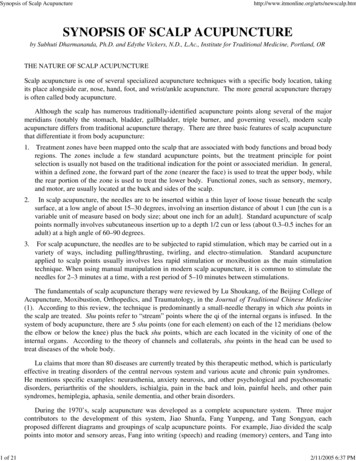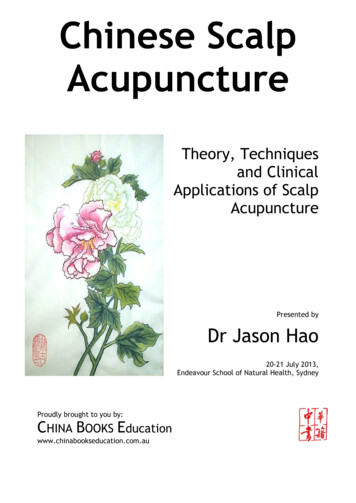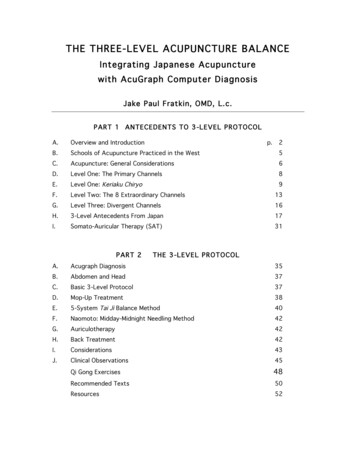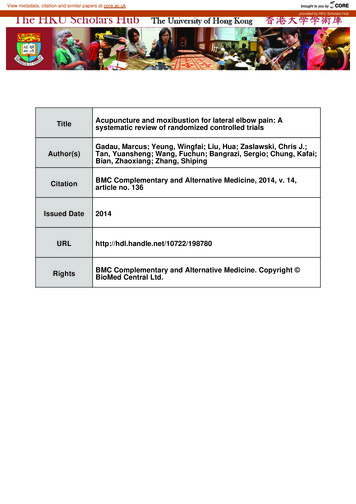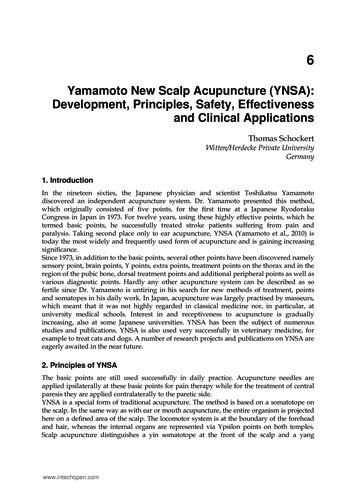
Transcription
6Yamamoto New Scalp Acupuncture (YNSA):Development, Principles, Safety, Effectivenessand Clinical ApplicationsThomas SchockertWitten/Herdecke Private UniversityGermany1. IntroductionIn the nineteen sixties, the Japanese physician and scientist Toshikatsu Yamamotodiscovered an independent acupuncture system. Dr. Yamamoto presented this method,which originally consisted of five points, for the first time at a Japanese RyodorakuCongress in Japan in 1973. For twelve years, using these highly effective points, which hetermed basic points, he successfully treated stroke patients suffering from pain andparalysis. Taking second place only to ear acupuncture, YNSA (Yamamoto et al., 2010) istoday the most widely and frequently used form of acupuncture and is gaining increasingsignificance.Since 1973, in addition to the basic points, several other points have been discovered namelysensory point, brain points, Y points, extra points, treatment points on the thorax and in theregion of the pubic bone, dorsal treatment points and additional peripheral points as well asvarious diagnostic points. Hardly any other acupuncture system can be described as sofertile since Dr. Yamamoto is untiring in his search for new methods of treatment, pointsand somatopes in his daily work. In Japan, acupuncture was largely practised by masseurs,which meant that it was not highly regarded in classical medicine nor, in particular, atuniversity medical schools. Interest in and receptiveness to acupuncture is graduallyincreasing, also at some Japanese universities. YNSA has been the subject of numerousstudies and publications. YNSA is also used very successfully in veterinary medicine, forexample to treat cats and dogs. A number of research projects and publications on YNSA areeagerly awaited in the near future.2. Principles of YNSAThe basic points are still used successfully in daily practice. Acupuncture needles areapplied ipsilaterally at these basic points for pain therapy while for the treatment of centralparesis they are applied contralaterally to the paretic side.YNSA is a special form of traditional acupuncture. The method is based on a somatotope onthe scalp. In the same way as with ear or mouth acupuncture, the entire organism is projectedhere on a defined area of the scalp. The locomotor system is at the boundary of the foreheadand hair, whereas the internal organs are represented via Ypsilon points on both temples.Scalp acupuncture distinguishes a yin somatotope at the front of the scalp and a yangwww.intechopen.com
84Acupuncture – Clinical Practice, Particular Techniques and Special Issuessomatotope at the back of the scalp. With the aid of the special Japanese neck diagnostics, theassociated Ypsilon therapy points in the temples or the corresponding cranial nerve points arerevealed via pressure-sensitive points in the neck region. As a representative of each meridian,there is a pressure point on the neck and an associated treatment point in the region of thetemples. If, for example, the kidney point on the neck is sensitive to pressure the needle isapplied to the corresponding Ypsilon point in the temple. If the needle has been correctlypositioned in the temple region then the pressure sensitivity in the neck disappearsconsecutively and thus provides immediate verification for correct positioning of the needle.Fig. 1. Schematic representation of the frontal YNSA basic points. Needles are appliedipsilaterally for the treatment of pain and contralaterally for the treatment of paralysis.www.intechopen.com
Yamamoto New Scalp Acupuncture (YNSA):Development, Principles, Safety, Efficacy and Clinical ApplicationsFig. 2. Ypsilon points. Abdominal or neck diagnosis leads to the selection of the Ypsilonpoints in a treatment sessionwww.intechopen.com85
86Acupuncture – Clinical Practice, Particular Techniques and Special IssuesFig. 3. The abdominal diagnosis leads to the Ypsilon or cranial nerve pointsIn contrast to the pulse and tongue diagnosis of traditional Chinese medicine, YamamotoNew Scalp Acupuncture (YNSA) is characterized by the special feature abdominal wall andneck diagnostics. These diagnostic procedures enable the acupuncture points to beidentified individually in each treatment situation indicating where the needles are to beapplied for each individual person in the respective treatment situation. When the needle iscorrectly positioned, the sensitivity to pressure felt by the physician and patient disappears.This check makes it possible to discover whether the needle is correctly positioned. It isimportant to investigate the diagnostic points on the arm and neck by shifting the pressureto the side. In doing so, the points are palpated with the tip of the thumb. Applying pressuresolely to the points may falsify the results of the examination. In the case of abdominal walldiagnostics, the examination is performed by palpation using the index, middle and ringfingers with gently circling movements.www.intechopen.com
Yamamoto New Scalp Acupuncture (YNSA):Development, Principles, Safety, Efficacy and Clinical Applications87Fig. 4. Neck diagnosis is used to find the treatment points of the patient2.1 Relevance of the YNSA cranial nerve pointsThe cranial nerve points are highly active acupuncture points on the frontal scalp. Usingthese points, disorders of the corresponding meridians and the cranial nerves can be treated.For example, the lung cranial nerve point, the glossopharyngeal point is used for thetreatment of the swallowing disorders after stroke as well as pulmonary disorders ofdifferent origin. Based on the YNSA-Yin basic point A, 12 cranial nerve points are located ina row in the dorsal direction up to DuMai20 for approximately 6-8 cm. For the practical use,the cranial nerve points are identified by the adbdominal or neck palpation technique. Thepainful abdominal or neck points show the way to the corresponding cranial nerve points.After correct acupuncture of the relevant cranial nerve points, the pain intensity of theabdominal or neck sites should be reduced, similar to the Ypsylon points. Similar to theother YNSA points, the cranial nerve points display small treatment areas, which arewww.intechopen.com
88Acupuncture – Clinical Practice, Particular Techniques and Special Issuesidentified using careful palpitation. Acupuncture is then performed at the point with thehighest pain intensity. Similar to the basic, brain and Ypsilon points, a careful palpitation isnecessary and important for the localization of the cranial nerve points. The known Ypsilonand cranial nerve points can be used alone and in combination. It is important that thetreated acupuncture point is reported as painful by the patient. A site which is not painfulshould not be treated. The cranial nerve points have shown to be very suitable for treatmentof motor and other neurological symptoms.Fig. 5. The cranial nerve points and brain points with Yin-basic-point Awww.intechopen.com
Yamamoto New Scalp Acupuncture (YNSA):Development, Principles, Safety, Efficacy and Clinical ApplicationsFig. 6. Master key points for tinnitus, upper and lower body with hoarseness pointswww.intechopen.com89
90Acupuncture – Clinical Practice, Particular Techniques and Special IssuesFig. 7. Yamamoto New Chest AcupunctureIn the Yamamoto New Chest Acupuncture pain is treated ipsilaterally, hemiparesiscontralterally. Very effective is especially the treatment of distubances of the locomotorsystem.www.intechopen.com
Yamamoto New Scalp Acupuncture (YNSA):Development, Principles, Safety, Efficacy and Clinical Applications913. On the safety of acupuncture in the Thoracic regionNumerous references to side effects caused by acupuncture treatment can be found inmedline. The investigation presented here was motivated in particular by reports ofpneumothorax after acupuncture. After an autopsy on a corpse, the depth of variousacupuncture needles penetrated into the thorax was investigated. The study was performedon a female corpse. For unknown reasons, the patient had been subjected to resuscitationand due to this measure had suffered a series of fractured ribs on the right-hand side. Issueinvestigated: Is it possible to apply acupuncture treatment safely in the thoracic region, inparticular intercostally? Observations: Acupuncture in the thoracic region involves a greateror lesser degree of risk depending on the thickness of the subcutaneous fatty tissue. Thelonger the needle, the greater is the risk. In view of the fact that in some places theintercostals muscles are only 2 to 3 mm thick, the ribs themselves in the present case are 3 to4 mm thick and the skin is 1 to 2 mm thick, in the case of a slim or cachectic person anacupuncture needle 1 cm in length can potentially lead to pneumothorax if appliedintercostally. In order to ensure the greatest possible safety in acupuncture, it is necessary tochoose needles that are as short and thin as possible and to apply them tangentially at theflattest possible angle. Additional safety can be achieved by moving the tip of the needletowards the rib or corpus sterni. If, as for example in the case of thoracic Yamamoto NewChest Acupuncture, the needles are to remain in position in the patient so that furtherphysiotherapy measures can be applied, then they must be secured by a good adhesiveplaster. It appears safest to apply the needles above the ribs and only above the xiphoidprocess, the corpus and manubrium sterni.Fig. 8. Acupuncture needles of various lengths. In comparison: The depth of penetration intothe subcutaneous fatty tissue can be seen. Penetration depth of the needles with respectivelengths of 10, 15 and 25 mm in relation to skin and subcutaneous tissue.www.intechopen.com
92Acupuncture – Clinical Practice, Particular Techniques and Special IssuesConclusions: The safety of acupuncture in the front thoracic region depends on the length ofthe needle and the angle at which the needle is inserted. The greatest possible safety can beachieved by applying short, thin needles above the ribs or towards the ribs or the corpussterni.Fig. 9. Intercostal acupuncture with 4 different types and lengths of needlesFig. 10. These acupuncture needles penetrating through the intercostal muscles and into thethorax.www.intechopen.com
Yamamoto New Scalp Acupuncture (YNSA):Development, Principles, Safety, Efficacy and Clinical ApplicationsFig. 11. The thickness of the ribs and the intercostal musclesFig. 12 The rib is 4 mm thickwww.intechopen.com93
94Acupuncture – Clinical Practice, Particular Techniques and Special Issues4. Effectiveness and clinical applications4.1 Functional Magnetic Resonance Imaging (fMRI)With the aid of functional magnetic resonance imaging (fMRI), it was possible todemonstrate the good effectiveness of YNSA for stroke patients. In this study, a new metalfree acupuncture needle developed by the author was applied. Benefits associated withYNSA have been shown in studies in patients after stroke, in patients with musculoskeletalpain and in emergency medicine. In the Western world stroke is still the leading cause ofdisability in adults, often in the form of hemiparesis. The goal of the investigationintroduced here was to correlate the effect of YNSA in hemiparetic stroke patients to corticalactivation visualized in fMRI. The neurological correlates of YNSA were studied in 17patients with ischaemic stroke in the right hemisphere suffering from residual paresis of theleft hand and in 19 healthy volunteers. A new acupuncture needle for magnetic resonanceimaging developed by Schockert was used in this study. Similar to the principle of anindwelling venous cannula, the needle is positioned in the acupoint, the steel cylinderremoved, and the remaining plastic part is fixed in the acupoint by a plaster. The size of theplastic part remaining in the acupoint corresponds approximately to an acupuncture needleof the dimensions 0.30 x 30 mm (Schockert et al., 2010).According to the ethical vote all participants have signed a consent before the treatment.The fMRI study was performed in a 1.5 tesla Philips MRI system (TR 3000 ms, TE 50 ms, FA90 ) in a box-car design. Patients were treated lying down and were instructed via videogoggles to open or close their left hand. The fMRI paradigm was: five conditions with 120sec duration each: 3sec closing of the fist, 2sec opening of the fist, 30 sec break. Three runs offMRI were performed: no acupuncture, sham acupuncture (patient is blinded: acupressurewithout insertion of a needle), real acupuncture. The data were analyzed using an SPM2evaluation program. All patients and volunteers were first subjected to sham acupunctureand then to YNSA. The sham acupuncture consisted of a single application of pressure by afinger nail in the centre of an imaginary line between TE23 and GB14. In the genuine YNSA,needles were applied to the Yin points of the Basal Ganglia, Cerebellum, and Basic point C.Of the 17 investigated patients, only five could be evaluated due to motion artefacts. Onaccount of inhomogeneous lesions no group analysis was performed as cortical activationwas different in each patient. Generally, in contrast to the sham acupuncture, genuineacupuncture was accompanied by significant cortical activation in the motor, premotor andsupplemental motor cortex.Eight of 17 patients felt subjectively better after the YNSA. The patients experienced areduction of spasm and an improvement of the movement of the paralysed upper extremities.The 5 patients from whom the data were evaluated all showed subjectively clinical benefitafter the YNSA treatment. Data from 13 healthy volunteers could be analysed withoutartefacts. In these subjects it was possible to perform a group analysis. In contrast to thepatients, the volunteers displayed a decrease in cortical activation during YNSA. Withoutacupuncture: Cortical activation was shown in the motor cortex, cingulate gyrus and occipitallobe. Sham acupuncture: Cortical activation identical to that in subjects without acupuncture.Genuine acupuncture: No activation in the cingulate gyrus. The cingulate gyrus is part of thelimbic system, a multimodal area with important afferent and efferent connections which isinvolved in planning of complex and difficult movements. Theoretically, a lack of activation inthe cingulate gyrus could be a training effect or the result of selective inhibition of this area bywww.intechopen.com
Yamamoto New Scalp Acupuncture (YNSA):Development, Principles, Safety, Efficacy and Clinical Applications95YNSA. Without acupuncture or with sham acupuncture cortical activation was observed closeto the region of the vertex of the scalp, where GV20 is situated. This activation is not seen aftergenuine acupuncture. So it is conceivable that this is a specific YNSA effect. The effects lookpromising but could be the result of generalised stimulation. The reliability of the data analysismust also be verified. The design of the study shows methodological deficits. For studies in thefuture the documentation has to be done even more thoroughly with objective methods ofmeasurement. The following practical problems were seen during the conduct of this study:Patients were lying down still in the scanner for about one hour. This was very tiring anddifficult for the patients. In addition, it is conceivable that patients had major concentrationproblems during the third block (genuine acupuncture). We assume the results of this studycould potentially support the use of YNSA as an adjunctive measure in stroke rehabilitation. Inview of the fact that eight patients felt subjectively better after the treatment and in view of thechanges in the cortical activations in the motor, premotor and supplemental motor cortex weassume that this benefit justifies the hypothesis that the YNSA treatment itself had this positiveinfluence and is the cause of the positive effects described by the patients. As stroke is theleading cause of disability in the western world we assume that it is justified to suggest furtherlarger controlled clinical trials and fMRI studies with more participants to investigate thephenomenon we have seen in this investigation (Schockert et al., 2010).4.2 YNSA in PET-CT4.2.1 YNSA activates cortical nociceptive and motor centers in patients with chronicpain of the locomotory systemThe clinical application of Yamamoto New Scalp Acupuncture (YNSA) often showsimmediate and long lasting effects in patients with locomotor disturbances such as painsyndromes, chronic stroke and Parkinson's disease. However, little is known about theunderlying mechanisms of YNSA.The aim of the study was to investigate potential areas of the central nervous systeminfluenced by YNSA in the treatment of such patients. To this end, changes in the cerebralglucose metabolism were measured by PET-CT. We measured three subjects that weretreated with YNSA for chronic pain syndromes in their lower extremities. Each patient wasmeasured twice. The first measurement served as a baseline scan to assess the basic brainactivity of the patient. The second measurement was acquired four to five days later, and thepatient was treated with YNSA shortly before the beginning of the scan. Points wereselected individually after YNSA neck diagnosis. A visual analogue scale (0-10) was used toassess pain reduction. Each subject's PET data were spatially coregistered to correct fordifferences in head position between the two scans. Consequently, the data were normalizedto a template brain and smoothed with a 12 mm isotropic kernel in order to account foranatomical differences between the subjects. Finally, demeaning was applied to correct forglobal changes of signal intensity. All these steps were carried out using SPM 8 (WellcomeTrust Center for Neuroimaging, London) and FSL 4.1 (FMRIB, Oxford), respectively. Afterthese pre-processing steps, data from the two measurements could be directly compared toeach other. An increase in glucose metabolism (and thus of cortical activity) of more than10% was considered significant. An average pain reduction of 4.4 2.7 points was achievedwith YNSA. PET data showed increased activity in the following cortical and subcorticalareas: thalamus, lateral frontal- und dorsolateral prefrontal cortex (DLPFC), insula, medialand ventromedial prefrontal cortex, posterior cingulate cortex (PCC), cerebellum, basalganglia and periaqueductal grey (PAG).www.intechopen.com
96Acupuncture – Clinical Practice, Particular Techniques and Special IssuesThe reported activations could all be assigned to either the nociceptive (thalamus, insula,DLPFC, PAG), motor (cerebellum, basal ganglia) or attention networks (PCC, lateral frontalcortices). As changes in the level of attention were not monitored in this study, they cannot beruled out. Thus we do not consider the observed activations in the attention network (PCC,lateral frontal cortices) a direct effect of YNSA. The average reduction in pain scale score andcorresponding change in nociception system activation can be considered a direct effect ofacupuncture. As VAS values were lower under YNSA as compared to baseline, theseactivations cannot simply be a result of the painful needle manipulation. The activation of themotor system, especially in the basal ganglia, offers a possible explanation for the efficacy ofYNSA in general locomotor disorders. In this context, it is interesting to note that the YNSApoint “basal ganglia” was used for treatment in two of the three subjects.Fig. 13. Group results of the PET measurement. Contrast: Scan with YNSA needles in place Baseline scan. Only signal changes of 10% and more are shown.4.3 YNSA in emergency medicineDue to the good effectiveness of YNSA, especially since YNSA takes effect very rapidly, Iwould like to propose that YNSA and other acupuncture methods could be applied assupportive measures both in emergency medicine and by the emergency services. YNSA hasalready been successfully employed by the emergency services. Acupuncture has also beenused in military applications. There is thus an urgent need for further extensive studies onthe application of acupuncture by the emergency services (Chen el al., 2010).4.3.1 YNSA in emergency medicine – a case reportVarious acupuncture methods are successfully applied in emergency medicine throughoutthe world and have also been studied scientifically. I myself regularly apply acupuncture inmy daily practice and in emergency medical work. In the case history described here, Iwould like to present YNSA and show that I have employed YNSA to support emergencymedical measures during pregnancy. The patient herself described YNSA as extremelywww.intechopen.com
Yamamoto New Scalp Acupuncture (YNSA):Development, Principles, Safety, Efficacy and Clinical Applications97effective and soothing. On 23 April 2007, an emergency call was passed on to the rescuevehicle from the control centre at 19:15 concerning a pregnant patient who was experiencingsevere back pain, dyspnoea and pain in the thorax. In a thorough physical examination ofthe 41-year-old patient an auscultation revealed that all sections of the lungs were freewithout any rattling noise or spasticity, after the immediate administration of oxygen theoxygen saturation was 99 %, blood pressure was 150/90 and pulse 100. An ECG did notshow any pathological abnormalities. After a venous cannula had been inserted into thebend of the left arm and lactated Ringer’s solution had been administered to the patient, adecision was taken to apply Yamamoto New Scalp Acupuncture as an analgesic. Uponcloser questioning, the patient said that she had severe thoracic and back pain, and that theback pain, which did not radiate into the legs, was the most problematic for her. She saidshe had not felt well all day, but she did not want to take any painkillers. The patient agreedto be treated by acupuncture as pain therapy. According to the current procedures forYNSA, a neck diagnosis was first applied. The neck diagnosis led to the identification of thecorrect acupuncture points for this patient. The following 8 points were applied: basic pointsA right and left, basic points D and E right, parietally situated Y point kidney and brainpoints cerebrum, cerebellum and basalganglia. All needles have been inserted for about 5milimeters into the scalp. Then the pressure sensitivity in the neck disappeared. There hasbeen no stimulation or rotation of the needles in this treatment. The patient had alreadybeen treated by acupuncture on previous occasions and also experienced rapid relief of hersymptoms by the scalp acupuncture applied under emergency conditions. Upon arrival inhospital, the patient had a complete relief from her symptoms.In his book on acupuncture in emergency medicine that appeared in 1994, Richard Umlaufdescribes the points for body acupuncture and the points of various microsystems for their usein difficult and life-threatening illnesses. He considers these methods very efficacious andrecommends their application. Acupuncture could be of great benefit in emergency medicine,especially for analgesic purposes since acupuncture may also be regarded as evidence-basedmedicine. Since the GERAC study this is particularly true of the treatment of knee and backpain. Although acupuncture research is under way throughout the world and acupuncture isalso used in the emergency services, acupuncture cannot yet be described as evidence-basedemergency medicine (EBEM). Like many other measures in complementary medicine,acupuncture offers a valuable, efficient and reliable adjuvant therapy option for all existingorthodox emergency treatments. Both for ethical and quite particularly for cost-saving reasons,the application of acupuncture and complementary medicine could also establish a permanentplace in emergency medicine. Larger clinical trials are warranted to investigate the YNSAeffects in emergency patients. In recent years, I have applied YNSA as a supportive measure oras a sole therapy for the relief of pain in a wide range of cases, for example acute renal colicand also for dyspnoea caused by asthma, in the emergency rescue service and also foremergency public health services. YNSA makes it possible to provide efficient therapy byapplying needles to just a few points. The international literature describes a wide range ofapplications of various forms of acupuncture – also including acupressure – for use inemergency medicine, but also side effects due to body acupuncture that has not been appliedcorrectly. As yet there are no articles on YNSA for emergency medicine in the internationalliterature. I would like to encourage a discussion on increasingly including YNSA and otheracupuncture methods in emergency public health services and also in emergency medicalservices as a complement to and in support of orthodox medicine. This will require extensivestudies on the application of acupuncture by the emergency services. I hope for the sake of allaffected emergency patients that acupuncture will be increasingly applied as an adjuvant andsupportive method in the emergency services.www.intechopen.com
98Acupuncture – Clinical Practice, Particular Techniques and Special IssuesFig. 14. Patient ready for transport: patient treated by ECG, oxygen and YNSA. The patientexperienced relief from all symptoms after treatment with just 8 needles.5. ConclusionWorking with YNSA is very encouraging and satisfying due to the frequently occurringimmediate effects and lightning effects. YNSA finds widespread acceptance amongst patients.6. AcknowledgmentDr. Toshikatsu Yamamoto, I thank you very much for teaching me your YNSA.7. ReferencesYamamoto T, Yamamoto H, Yamamoto MM. (2010) Yamamoto New Scalp Acupuncture,YNSA. Yamamoto Publishing Inc. Miyazaki, JapanChen Y-L, Hou MC, Huang S-Y, Schockert T. Yamamoto New Scalp Acupuncture (YNSA)Use in Emergency Medicine. Journal of Chinese Medical Association ofAcupuncture Taiwan 2010;13,2:1-8Schockert T. Integration of Yamamoto New Scalp Acupuncture (YNSA) into emergencymedicine. Deutsch Zeitschr f Akup 2010;4,34-37Schockert T, Beissner F. Neurophysiological Correlates of the Effect of YNSA for Patientswith Chronic Pain of the Locomotor System - Basic YNSA Research by Means ofPET-CT. Deutsch Ztschr f Akup. 2010;2:8-13Schockert T, Schnitker R, Boroojerdi B, Vietzke K, Qua Smith I, Yamamoto T, Kastrau F.Cortical Activation by Yamamoto New Scalp Acupuncture (YNSA) in theTreatment of Stroke Patients - A Sham-controlled Study Using Functional MagneticResonance Imaging (fMRI). Acupunct Med 2010;4:212-4www.intechopen.com
Acupuncture - Clinical Practice, Particular Techniques and SpecialIssuesEdited by Prof. Marcelo SaadISBN 978-953-307-630-0Hard cover, 138 pagesPublisher InTechPublished online 06, September, 2011Published in print edition September, 2011Acupuncture is growing in popularity world-wide. Acupuncture and related techniques are useful tools fortreating a spectrum of diseases. However, there are still many areas of controversy connected to it due to thefact that mechanisms of action of acupuncture are not entirely clear. Another debilitating element is theabsence of a convincing model of sham acupuncture for a control group in clinical trials.Therefore, there arestill inappropriate prejudice and unfamiliarity regarding acupuncture. I hope this book can contribute to guidethe advance of this ancient medical art. The reader will here find texts wrote by authors from different parts ofthe world. The chapters cover strategic areas to collaborate with the consolidation of the knowledge inacupuncture. The main objective is to share elements to make acupuncture more and better offered at healthsystems worldwide.How to referenceIn order to correctly reference this scholarly work, feel free to copy and paste the following:Thomas Schockert (2011). Yamamoto New Scalp Acupuncture (YNSA): Development, Principles, Safety,Effectiveness and Clinical Applications, Acupuncture - Clinical Practice, Particular Techniques and SpecialIssues, Prof. Marcelo Saad (Ed.), ISBN: 978-953-307-630-0, InTech, Available pplicaInTech EuropeUniversity Campus STeP RiSlavka Krautzeka 83/A51000 Rijeka, CroatiaPhone: 385 (51) 770 447Fax: 385 (51) 686 166www.intechopen.comInTech ChinaUnit 405, Office Block, Hotel Equatorial ShanghaiNo.65, Yan An Road (West), Shanghai, 200040, ChinaPhone: 86-21-62489820Fax: 86-21-62489821
2011 The Author(s). Licensee IntechOpen. This chapter is distributedunder the terms of the Creative Commons Attribution-NonCommercialShareAlike-3.0 License, which permits use, distribution and reproduction fornon-commercial purposes, provided the original is properly cited andderivative works building on this content are distributed under the samelicense.
Acupuncture Clinical Practice, Partic ular Techniques and Special Issues 86 Fig. 3. The abdominal diagnosis leads to the Ypsilon or cranial nerve points In contrast to the pulse and tongue diagnosis of traditional Chinese medicine, Yamamoto New Scalp Acupuncture (YNSA) is characterized by the special feature abdominal wall and neck diagnostics.
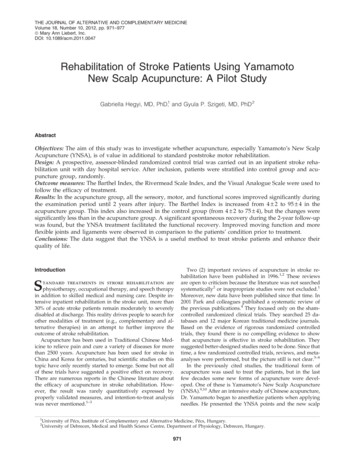
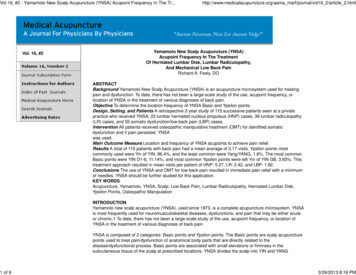
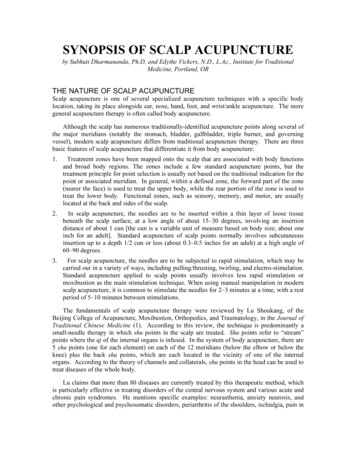

![[T] Effects of Ai Chi and Yamamoto new scalp acupuncture on chronic low .](/img/60/camilotti-bm-et-al-2015-low-back-pain-and-ai-chi-2.jpg)

